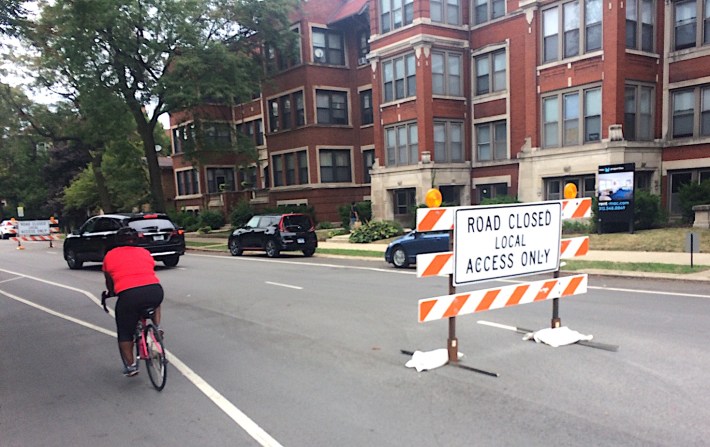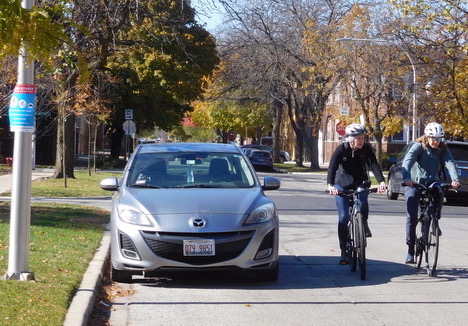Today the Chicago Department of Transportation relaunched the Slow Streets (the city calls them "Shared Streets") program by reopening the Leland Slow Street. Slow Street treatments use barricades and traffic barrels to ban motorized through traffic and calm local traffic to allow for safe, socially-distanced walking and biking in the street. This year the program will be backed by $500,000 in funding and expanded to 12 to 13 miles of street space. The Active Transportation Alliance recently released its analysis of Chicago’s 2020 Slow Streets Program. ATA also surveyed organizations and residents near the 2020 Slow Streets corridors
Most of the respondents to ATA’s survey were white North Side residents. Most of the feedback focused on the Leland Avenue and Cortland Slow Streets. ATA acknowledged that this feedback was “far from representative” of the collective experience of Slow Streets in Chicago. Many respondents saw the Slow Streets as a safe recreational amenity as opposed to a useful transportation option. One respondent is quoted as saying, ““The [Slow Street] nearest to me seemed like a palliative gesture — it’s not a highly-trafficked street nor a corridor heavily relied upon to connect to services or transit. It was mostly for recreation.”
According to ATA, results were mixed when respondents were asked to comment on how Slow Streets addressed the needs of the vulnerable and marginalized. Some respondents commented on seeing more older adults and people with disabilities using Slow Streets. However, one person who described themselves as an older disabled adult stated they did not feel safe on the Slow Street due to a lack of courtesy from people driving and biking.
Respondents voiced concerns about speeding and/or aggressive drivers, unclear signs, vague or unclear messaging around Slow Streets, and barriers being moved. ATA crafted their recommendations based on respondents’ feedback. ATA recommends more direct outreach in order to explain the purpose and benefits of Slow Streets and to obtain feedback from residents. ATA also recommends posting Slow Street routes on Google Maps and other navigation tools in order to to give advance notice to motorists, including delivery drivers and ride-hail workers. This could help motorists avoid Slow Streets or be prepared to slow down.
I’m skeptical drivers will actually slow down because Google Maps or some other navigation tool tells them to. It would be helpful if ride-hail companies penalized drivers for speeding along a Slow Street or any street for that matter. ATA also recommends larger fonts for Slow Street signs in order to make it easier for drivers to read that they need to proceed with care and drive slowly. My own experience along streets with signs indicating a 20 mph speed limit and drivers going well above the posted speed limit makes me doubtful signs alone will be enough to get drivers to slow down.
ATA recommends that CDOT recruit community partners or volunteers to act as "stewards" of slow streets. Stewards would talk with residents about the Slow Street, replace moved barriers, and help activate the street with programming. Oakland, CA, was cited as a positive example of culturally responsive slow streets. The city worked with local artists to build barricade planters and create culturally relevant signs. I would love to see colorful concrete or steel planters used as traffic diverters along some of Chicago’s side streets.

Lastly, ATA recommends CDOT rethink some of the Slow Street locations in order to assist residents with day to day transportation needs such as grocery visits, library trips, parks, and commercial centers. Many respondents stated that Slow Streets did not help them with traveling to where they need to go. This makes sense, because it appears the shared streets were chosen with more concern for political feasibility than promoting mobility. This reflects CDOT’s typical approach toward cycling: Paint bike lanes where there will be the least political opposition, not necessarily building the needed types of bike infrastructure, in the necessary locations to attract and retain new riders and significantly grow bike mode share.
Opponents and supporters of Slow Streets agree that we need permanent infrastructure. Respondents to ATA’s survey want to see protected bike lanes, safer intersections, traffic circles, repaired or new sidewalks, and bus lanes. This is not new information, but I would be curious to learn citywide views on these infrastructure investments.






